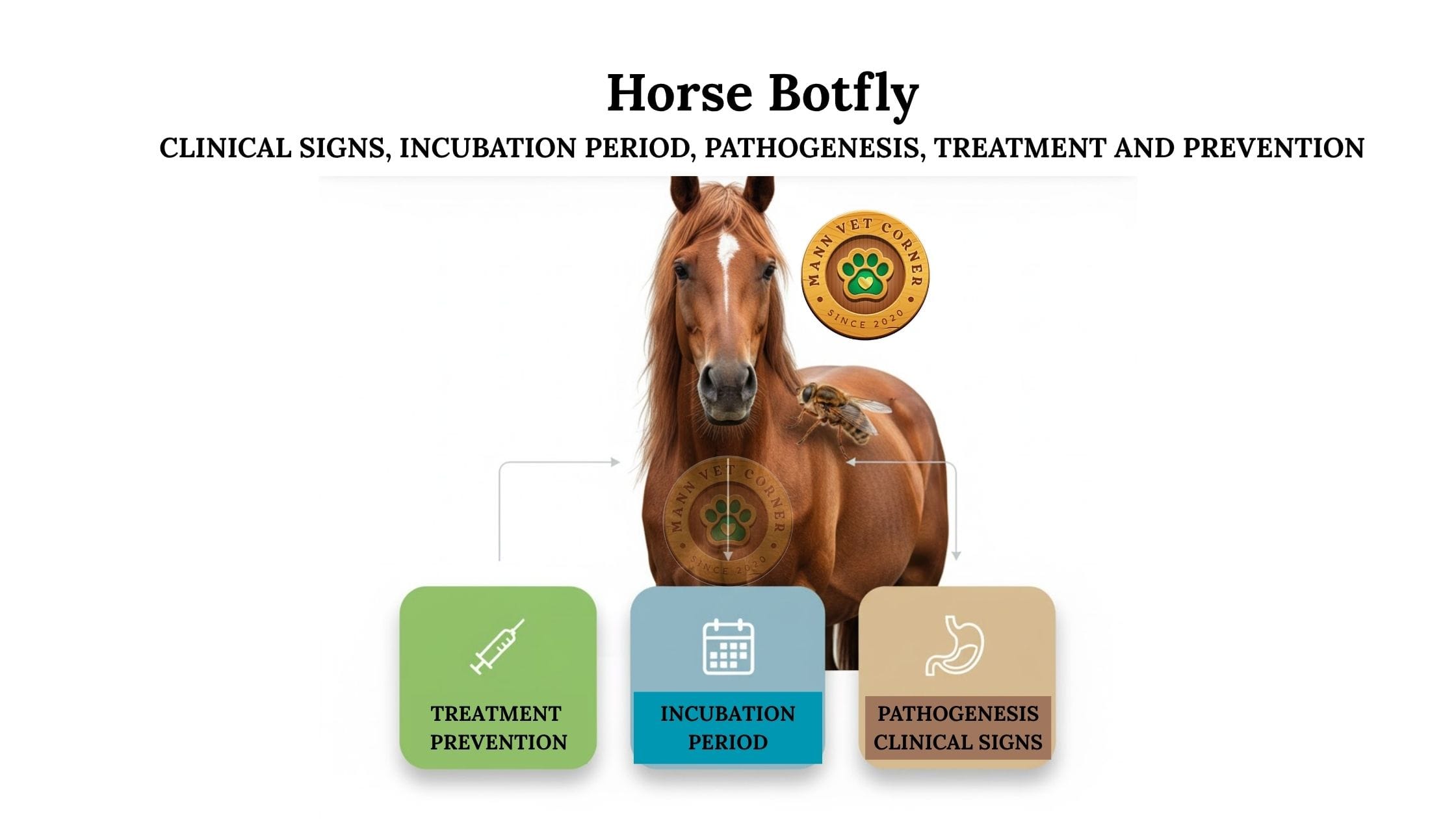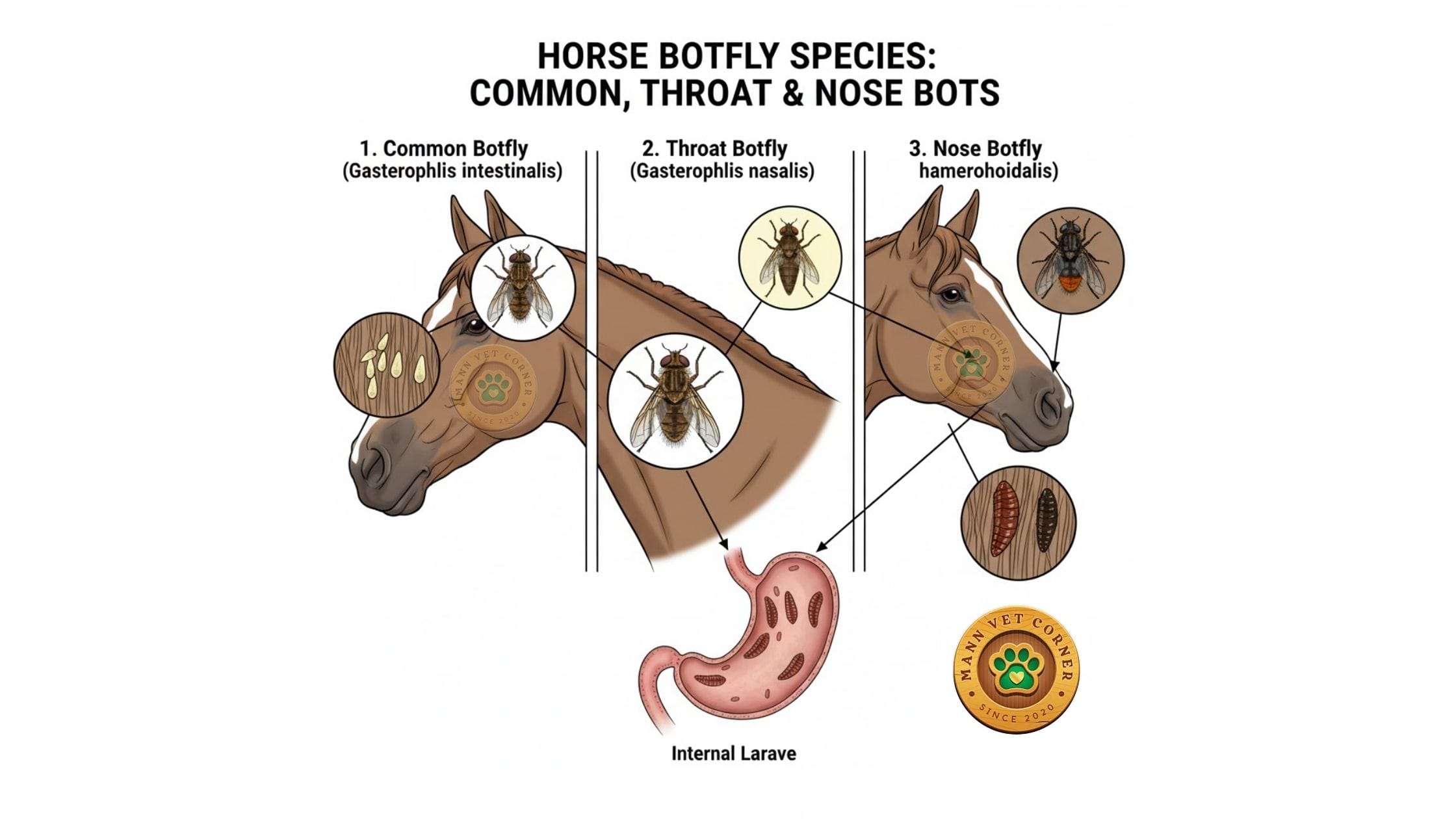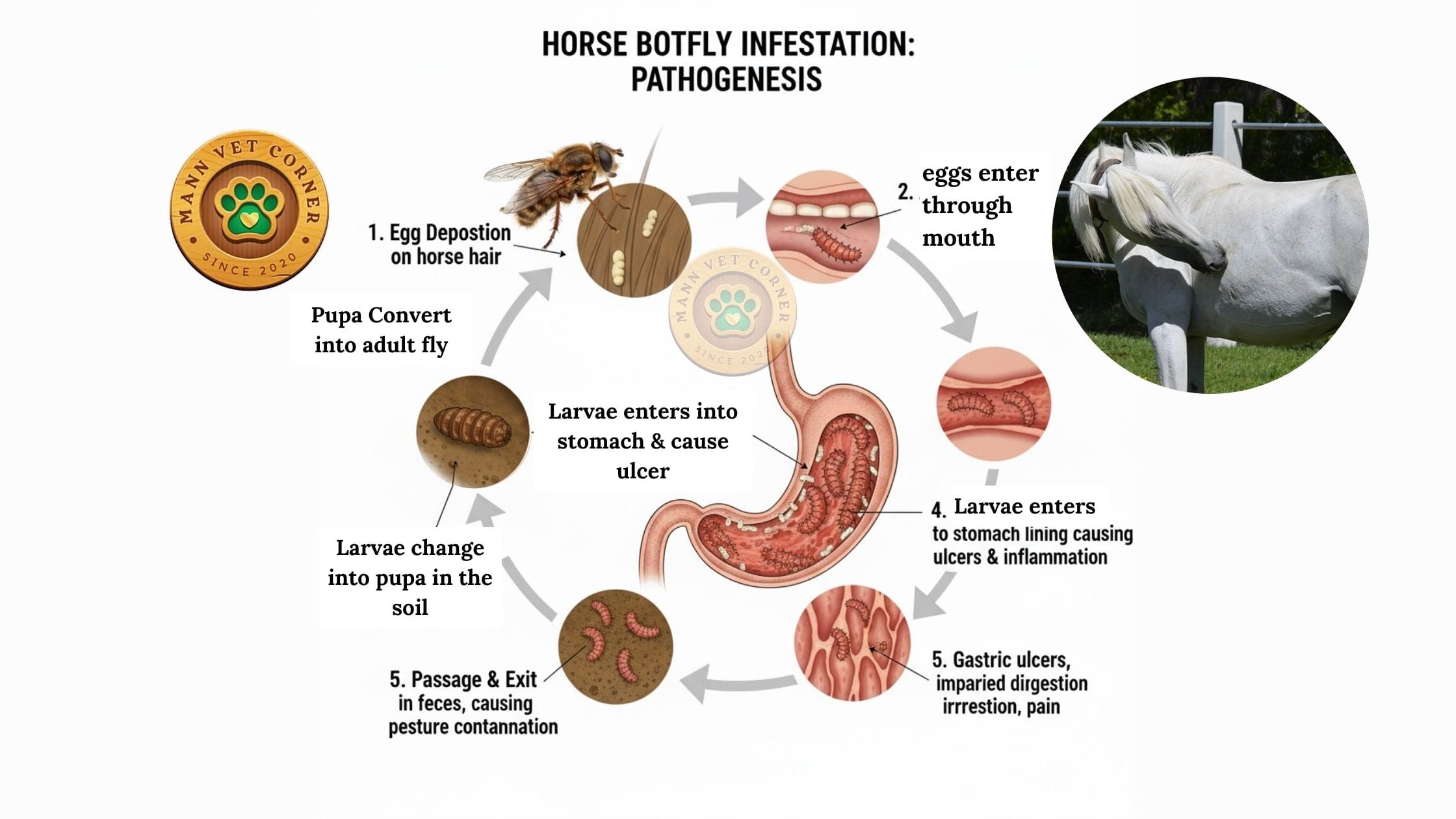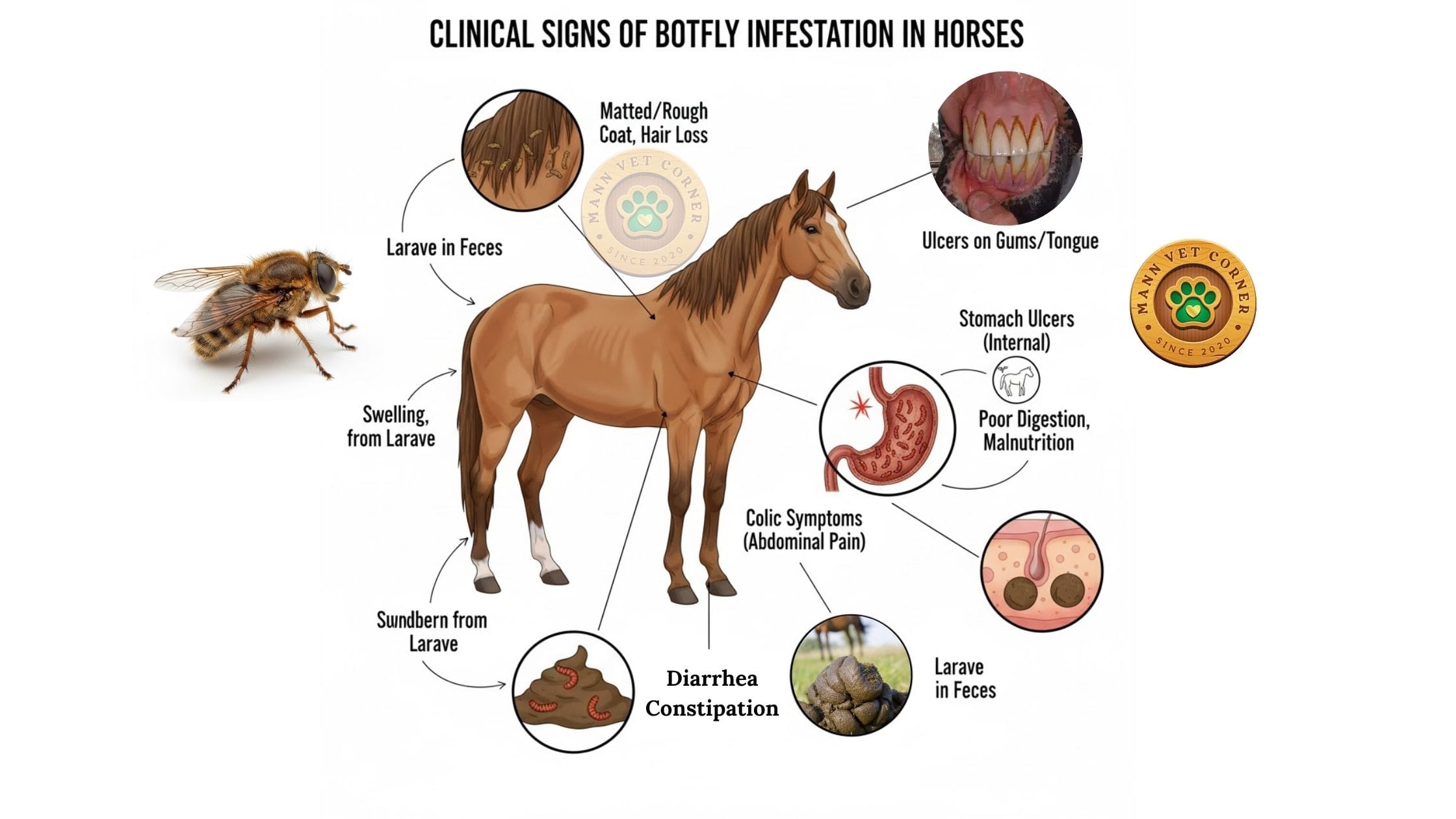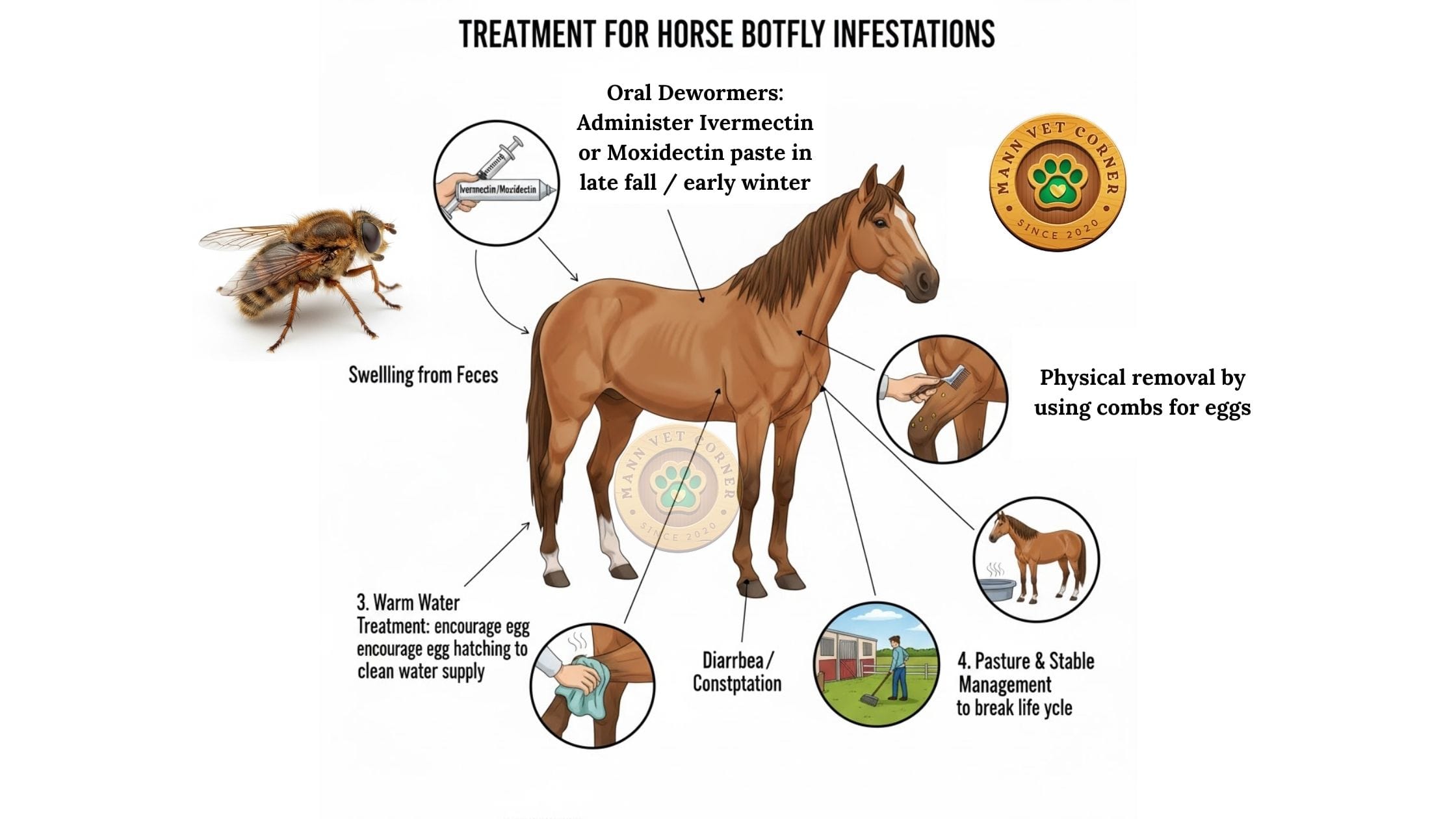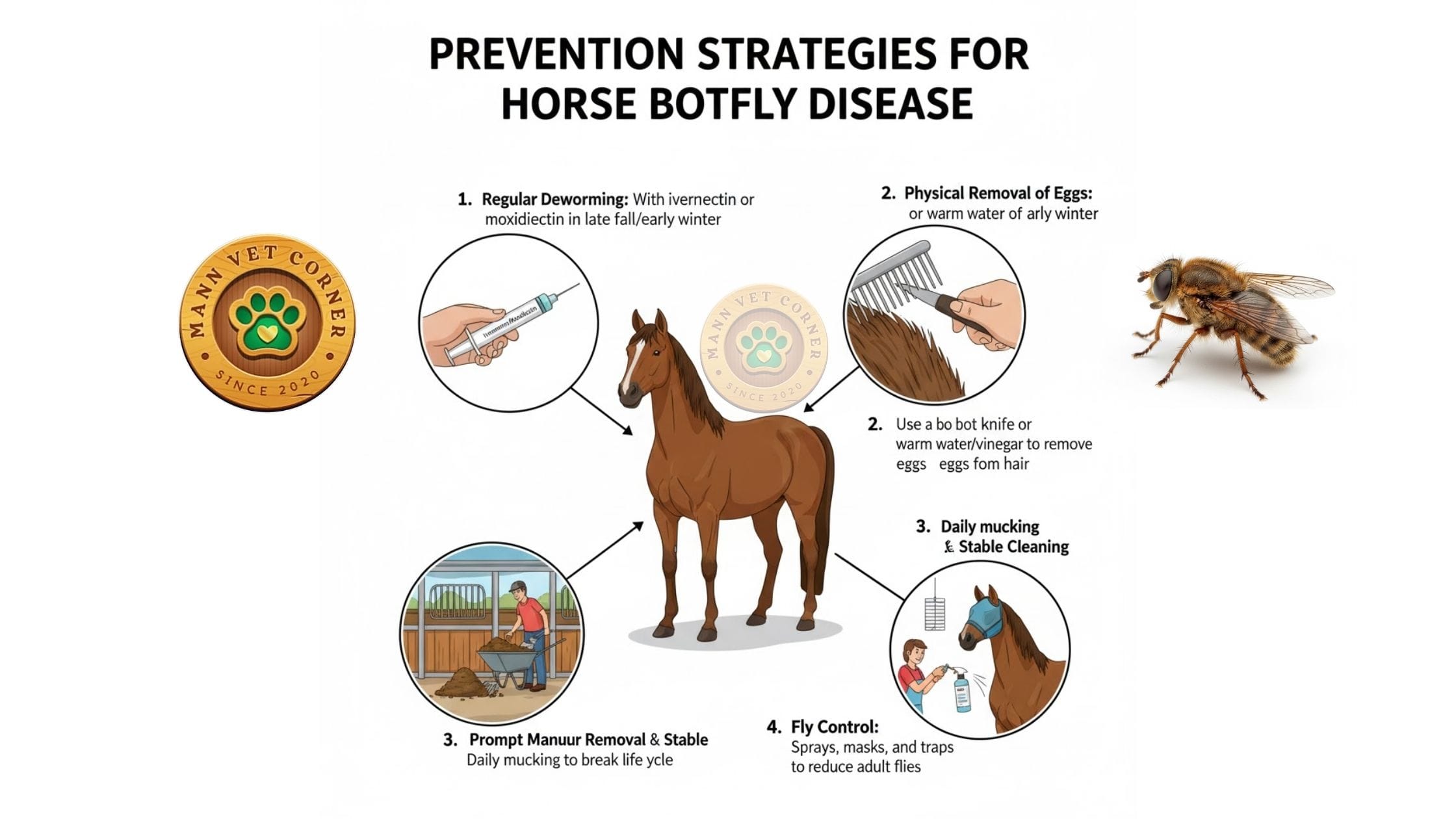Horse botflies (Gasterophilus spp.) infest horses by laying eggs on their coat, which hatch and migrate through the mouth and gastrointestinal tract. Clinical signs include irritation, licking, restlessness, and digestive disturbances. The incubation period varies by species, lasting days to weeks. Pathogenesis involves mucosal damage and inflammation from larval migration. Treatment relies on anthelmintics like ivermectin or moxidectin and manual egg removal. Prevention includes regular grooming, timely deworming, and fly control to protect equine health. This comprehensive guide on the Horse Botflies: Clinical Signs, Incubation Period, Pathogenesis, Treatment & Prevention will help to every horse owner and vet practioner.
What Are Horse Botflies and Why Should Equine Owners Care?
Horse botflies represent one of the most persistent parasitic threats facing horse owners worldwide. These flying insects don’t just annoy your horses, they complete their entire life cycle using equines as hosts, potentially causing serious internal damage. Understanding botfly infestations in horses helps you protect your animals from complications ranging from mild digestive upset to life-threatening intestinal blockages.
The three main species affecting horses include Gasterophilus intestinalis (common bot), Gasterophilus nasalis (nose botfly), and Gasterophilus haemorrhoidalis (throat botfly). Each species targets different areas of your horse’s body, making comprehensive prevention strategies essential for every stable.
Understanding the Horse Botfly Life Cycle: From Egg to Adult
The Four-Stage Development Process
The botfly life cycle in horses follows a fascinating yet troubling pattern that spans several months. Horse bot fly’s life cycle is key to controlling them effectively: Adult female bot flies lay eggs on the horse’s coat during warm weather (typically late summer and early autumn). Eggs hatch after about 5-10 days, stimulated by the horse’s licking. Here’s how these parasites develop:
Stage 1: Egg Laying (Summer Months) Adult botflies emerge during warm weather, typically from late spring through early fall. Female flies don’t bite or feed—they focus entirely on laying eggs. A single female deposits 150-500 tiny yellow or white eggs directly onto horse hair, usually on the legs, shoulders, chest, and sometimes around the mouth area.
Stage 2: Egg Incubation and Larval Activation The incubation period for botfly eggs varies by species. Common bot eggs hatch when horses lick themselves, triggered by moisture and warmth from the tongue. This process takes 5-7 days. Nose botfly eggs hatch spontaneously after 4-5 days, while throat botfly eggs require friction from lips or tongue and typically hatch within 2-4 days.
Stage 3: Internal Development (8-12 Months) Once larvae enter the horse’s mouth, they burrow into gum tissue for 3-4 weeks before migrating to the stomach. Here’s where serious problems begin. Larvae attach to stomach walls using specialized hooks, feeding on blood and tissue for 8-10 months during fall, winter, and spring. They molt twice during this period, growing from first-stage to third-stage larvae.
Stage 4: Exit and Pupation In late spring or early summer, mature larvae release their grip and pass through the intestinal tract. They exit in manure, burrow into soil, and form protective pupae. After 3-8 weeks (depending on temperature), adult flies emerge to restart the cycle.
How Horse Botfly Infestations Develop: Pathogenesis Explained
Horse bots are the larvae of botflies, Gasterophilus spp. There are several species of botflies that can affect horses. While this is one of the most common parasitic infections, it generally leaves horses unaffected and is easily treated.
Internal Damage Mechanisms
The pathogenesis of bot fly disease in horses occurs through multiple mechanisms that compromise equine health:
Oral and Pharyngeal Irritation When larvae first enter the mouth, they cause immediate tissue damage. Horses experience painful sores on gums, tongue, and throat lining. This initial invasion triggers inflammation and can interfere with normal eating behavior.
Gastric Attachment and Ulceration Larvae attach to the stomach’s non-glandular region using rows of sharp hooks. This attachment creates focal ulcers, erodes protective mucosa, and triggers chronic inflammation. Heavy infestations (over 100 larvae) significantly increase ulcer severity. The damaged stomach lining loses its ability to protect against digestive acids, leading to secondary complications.
Pyloric Obstruction Risk Throat botfly larvae specifically target the pyloric region where the stomach connects to the small intestine. Clusters of larvae here can create partial or complete blockages, preventing normal food passage and causing potentially fatal complications.
Intestinal and Rectal Irritation As mature larvae pass through intestines, they cause additional mucosal damage. Some larvae pause near the rectum before exiting, creating inflammation, discomfort, and visible irritation around the anal area.
Systemic Effects Heavy infestations trigger systemic responses including anemia from blood loss, protein depletion, weight loss, and compromised immune function. Horses fighting severe parasitism struggle to maintain body condition despite adequate nutrition.
Clinical Signs of Botfly Infestation in Horses: What to Watch For
Clinical signs include excessive salivation, head shaking, oral irritation, chewing difficulties, and gastric issues. This irritation can prompt horses to lick and bite at affected areas, leading to further discomfort.
Early Warning Symptoms
Recognizing bot fly symptoms in horses early improves treatment outcomes. Watch for these clinical indicators:
Visible External Signs
- Yellow or cream-colored eggs attached to leg, chest, or facial hair (easiest to spot)
- Excessive rubbing or biting at egg-laden areas
- Visible irritation around mouth, nostrils, or under jaw
- Head shaking or facial discomfort when throat flies are active
Digestive System Indicators
- Reduced appetite or reluctance to eat normally
- Weight loss despite adequate feed
- Poor body condition score
- Dull, rough hair coat
- Intermittent mild colic episodes
- Changes in manure consistency or frequency
Behavioral Changes
- Irritability during feeding times
- Excessive salivation
- Difficulty swallowing or chewing
- Reduced performance or energy levels
- Restlessness or discomfort after eating
Severe Infestation Warning Signs
- Chronic colic that doesn’t respond to routine treatment
- Significant weight loss (over 10% body weight)
- Severe anemia (pale gums, weakness)
- Gastric rupture (rare but fatal)
- Rectal prolapse from straining
Many horses with light to moderate infestations show minimal outward signs, making regular monitoring and preventive treatment essential rather than relying on symptoms alone.

Effective Treatment Options for Horse Botfly Infestations
Use a dewormer containing ivermectin or moxidectin, which are effective against botfly larvae. Consult a Vet: Always consult with your veterinarian to determine the best deworming schedule and product for your horses.
Chemical Control Methods
Treating botflies in horses requires strategic use of antiparasitic drugs:
Ivermectin-Based Dewormers Ivermectin remains the gold standard for bot larvae treatment. A single oral dose (0.2 mg/kg body weight) effectively kills all larval stages in the stomach. Administer treatment in late fall or early winter after fly activity ceases but before larvae cause maximum damage. Popular brands include Zimecterin, Equell, and IverCare.
Moxidectin Products Moxidectin (0.4 mg/kg) provides excellent efficacy against botfly larvae with longer residual activity than ivermectin. Products like Quest and Quest Plus offer extended protection between treatments.
Combination Dewormers Many horse owners prefer combination products containing ivermectin or moxidectin plus praziquantel for concurrent tapeworm control. These dual-action dewormers maximize parasite coverage in a single treatment.
Treatment Timing Strategy The optimal botfly treatment schedule follows this pattern:
- Late fall/early winter: Primary treatment after first hard frost kills adult flies
- Spring: Optional second treatment before larvae pass (though usually unnecessary)
- Never deworm during summer when only eggs are present—wait until larvae have migrated to stomach
Important Treatment Considerations
- Rotate dewormer classes annually to prevent resistance
- Conduct fecal egg counts to assess overall parasite burden (note: botfly larvae don’t shed eggs, so counts won’t detect them)
- Treat all horses on the property simultaneously
- Young horses (under 3 years) require more frequent deworming
- Pregnant mares can safely receive ivermectin and moxidectin
Physical Egg Removal
While deworming kills internal larvae, physical removal of eggs prevents new infestations:
Manual Removal Techniques
- Bot knives (special combs with fine serrated edges) effectively scrape eggs from hair
- Warm water sponging softens egg cement for easier removal
- Single-edge razors carefully scrape eggs when used at proper angles
- Fine-toothed metal combs pull eggs from hair shafts
Removal Schedule Check horses every 3-5 days during bot fly season (summer through fall). Focus on front legs, chest, throat, and jaw areas where flies most commonly deposit eggs.
Prevention Strategies: Keeping Your Horses Bot-Free
A proper deworming protocol can prevent your horse from having any major internal disease caused by botflies. Most often, ivermectin is the dewormer of choice for botflies. Deworming in the fall with a boticide can help reduce the larval burden going into the winter.
Integrated Pest Management Approach
Effective botfly prevention in horses combines multiple strategies:
Strategic Deworming Programs Work with your veterinarian to develop a targeted deworming schedule based on your farm’s parasite pressure. Modern programs emphasize treating high shedders more frequently while reducing unnecessary treatments in low shedders. However, ALL horses should receive annual botfly treatment since larvae don’t shed eggs for detection.
Environmental Management
- Manure management: Remove manure from paddocks at least twice weekly to reduce pupation sites
- Pasture rotation: Move horses between fields to break parasite life cycles
- Proper drainage: Eliminate standing water and muddy areas
- Mowing: Keep grass short to reduce fly habitat
Fly Control Measures
- Fly masks and sheets: Physical barriers reduce fly access during peak activity
- Fly sprays: Repellents containing pyrethrin or permethrin deter adult botflies
- Stable fans: Strong air circulation makes it difficult for flies to land
- Fly traps: Reduce overall fly populations around barn areas
Seasonal Management
- Stable horses during peak botfly activity (mid-morning to early afternoon in summer)
- Schedule turnout for early morning or evening when flies are less active
- Groom horses daily during summer to detect and remove fresh eggs
- Wash legs and body with warm water after turnout to trigger and destroy eggs before horses self-groom
Pasture Companions Grazing horses alongside cattle, sheep, or goats dilutes botfly egg-laying sites. While these species don’t serve as suitable hosts, their presence creates a “decoy effect” that may reduce egg density on horses.
Biosecurity Measures
- Quarantine new horses for 4-6 weeks with deworming upon arrival
- Check visiting horses for bot eggs before allowing contact
- Maintain separate grooming tools for each horse
- Deworm before transporting horses to shows or events
Practical Tips for Horse Owners: Daily Management
How To Repel Bot Flies From Horses? Preventing bot flies in horses involves several practices: regularly clean and compost manure, manage pastures through mowing and chain harrowing, and implement rotational grazing. Avoid ground feeding and daily removal of bot fly eggs from horses is essential.
Building Your Bot Control Program
Spring Actions (March-May)
- Schedule your veterinarian’s spring farm visit
- Conduct fecal egg counts to establish baseline parasite levels
- Begin fly control preparations before warm weather arrives
- Check storage and expiration dates on dewormers
Summer Actions (June-September)
- Implement aggressive egg removal program
- Check horses every 3-5 days for new egg deposits
- Apply fly repellents before turnout
- Maintain strict manure removal schedule
- Consider stabling during peak fly hours
Fall Actions (October-November)
- Watch for first hard frost signaling end of fly season
- Wait 4-6 weeks after frost before deworming
- Administer ivermectin or moxidectin to all horses
- Document treatment dates and products used
- Order winter deworming supplies
Winter Actions (December-February)
- Larvae complete development in horse stomachs
- Plan next year’s parasite control strategy
- Review treatment records and effectiveness
- Schedule spring veterinary consultation
- Research any new products or recommendations
Frequently Asked Questions About Horse Botflies
How long do botfly eggs stay on horses? Botfly eggs remain viable on horse hair for 5-7 days depending on species and environmental conditions. Without intervention, they hatch when horses lick themselves or spontaneously in warm weather.
Can you see bot larvae in horse manure? Yes, during late spring and early summer, you may observe reddish-brown larvae (about 3/4 inch long) in fresh manure. This indicates larvae are exiting to pupate, confirming the need for fall treatment.
Do all horses need botfly treatment? Yes, all horses sharing a property should receive annual botfly treatment regardless of individual fecal egg counts. Bot larvae don’t produce eggs in manure, so testing doesn’t detect them.
Are botflies dangerous to humans? Horse botflies rarely affect humans. While adult flies may cause anxiety in people sensitive to insects, they don’t bite. Accidental larval infestations in human skin are extremely rare and typically benign.
What’s the difference between bot eggs and lice nits? Bot eggs appear yellow or cream-colored, cement firmly to hair shafts, and concentrate on legs and chest. Lice nits look white or grayish, attach near the skin on mane and tail areas, and don’t scrape off as easily.
Frequently Asked Questions About Treatment & Prevention
Can botflies kill horses? While rare, severe botfly infestations can cause fatal complications including gastric rupture, intestinal obstruction, or severe colic. Most cases respond well to appropriate treatment when caught early.
How many times per year should horses be dewormed for bots? One strategic treatment in late fall or early winter effectively controls bot larvae. Additional deworming throughout the year should target other parasites based on fecal testing and veterinary guidance.
Do natural dewormers work against botflies? No scientific evidence supports natural or herbal dewormers for botfly larvae elimination. Only proven anthelmintics like ivermectin and moxidectin reliably kill internal larvae.
Why are bot eggs yellow on some horses and white on others? Egg color varies by botfly species. Gasterophilus intestinalis lays yellow eggs, G. nasalis deposits yellow-orange eggs, and G. haemorrhoidalis creates black eggs. All require removal and treatment.
Can botflies develop resistance to ivermectin? Currently, botfly resistance to ivermectin remains rare in horses. However, proper rotation of dewormer classes and strategic treatment timing help preserve drug effectiveness for all equine parasites.
Conclusion: Taking Control of Botfly Management
Horse botflies present a manageable challenge when you implement comprehensive prevention and treatment strategies. The key lies in understanding their life cycle, recognizing clinical signs early, removing eggs diligently during summer months, and administering strategic deworming treatments in late fall.
Your parasite control program should emphasize both chemical treatments and environmental management. Work closely with your equine veterinarian to tailor approaches based on your specific farm situation, local climate, and individual horse needs.
Remember that consistency matters more than perfection. Regular grooming, scheduled egg removal, strategic deworming, and maintaining good farm hygiene create an environment where botflies struggle to complete their life cycle. Your horses will reward your efforts with better health, improved performance, and greater comfort throughout the year.
By staying vigilant and proactive, you protect your horses from the hidden damage these parasites cause while maintaining their overall wellbeing and performance potential.
